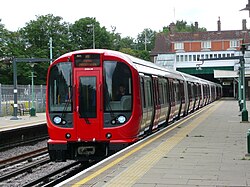
Back خط متروبوليتان Arabic متروپوليتان لاين ARZ Metropoliten xətti Azerbaijani মেট্রোপলিটন লাইন Bengali/Bangla Metropolitan Line Catalan Metropolitan Line (linka metra v Londýně) Czech Metropolitan Line Welsh Metropolitan line Danish Metropolitan Line German Metropolitan Line Spanish
| Metropolitan line | |
|---|---|
 | |
| Overview | |
| Stations | 34 (10 step free) |
| Colour on map | Magenta[1][2] |
| Website | http://tfl.gov.uk |
| Service | |
| Type | |
| System | London Underground |
| Depot(s) | Neasden |
| Rolling stock | S8 Stock |
| Ridership | 93.670 million (2019)[3] passenger journeys |
| History | |
| Opened | 10 January 1863 |
| Last extension | 1925 |
| Technical | |
| Line length | 67 km (42 mi) |
| Number of tracks | 2, except |
| Character | Sub-surface |
| Track gauge | 1,435 mm (4 ft 8+1⁄2 in) standard gauge |
| Electrification | Fourth rail, 750 V DC |
| Operating speed | 62 mph (100 km/h) maximum |
The Metropolitan line, colloquially known as the Met, is a London Underground line between Aldgate in the City of London and Amersham and Chesham in Buckinghamshire, with branches to Watford in Hertfordshire and Uxbridge in Hillingdon. Printed in magenta on the tube map, the line is 41.4 miles (66.7 km) in length and serves 34 stations (13 of which are step free to platform). Between Aldgate and Finchley Road, the track is mostly in shallow "cut and cover" tunnels, apart from short sections at Barbican and Farringdon stations. The rest of the line is above ground, with a loading gauge of a similar size to those on main lines. Just under 94 million passenger journeys were made on the line in 2019.
The line is one of just two Underground lines to cross the Greater London boundary (the other being the Central line). It is the only Underground line with an express service at peak times; the resulting longer distance between stations means trains can achieve the system's highest speeds of over 60 miles per hour (100 km/h) on some sections.
In 1863, the Metropolitan Railway began the world's first underground railway between Paddington and Farringdon with wooden carriages and steam locomotives, but its most important route became the line north-west into the Middlesex countryside, where it stimulated the development of new suburbs. Harrow was reached in 1880, and ultimately the line continued as far as Verney Junction in Buckinghamshire, more than 50 miles (80 km) from Baker Street. From the end of the 19th century, the railway shared tracks with the Great Central Railway out of Marylebone. The central London lines were electrified by 1907 but electric locomotives were exchanged for steam locomotives on trains heading north of Harrow. After the railway was absorbed by the London Passenger Transport Board in 1933, the line was cut back to Aylesbury. Steam trains ran until 1961, when the line was electrified to and services were curtailed at Amersham. The Hammersmith & City line was shown on the tube map as a part of the Metropolitan line until 1990, when it appeared as a separate line. The current S8 Stock trains entered service between 2010 and 2012, replacing the A Stock trains, that served the line since 1961.
The section between Aldgate and Baker Street is shared with the Circle line; between Liverpool Street and Baker Street with the Hammersmith & City line; between Rayners Lane and Uxbridge with the Piccadilly line; and between Harrow-on-the-Hill and Amersham with the London–Aylesbury line operated by Chiltern Railways. Baker Street is the southbound terminus for some trains not continuing to Aldgate. Most of the route has two tracks, except for the single-track Chesham branch and a four-track section between Wembley Park and Moor Park that allows fast and semi-fast services to overtake "all stations" trains. There are four tracks between Wembley Park and Finchley Road, but only the outer ones are used by the Metropolitan line's non-stop trains: the inner pair was transferred to the Bakerloo line in 1939 (becoming the Jubilee line in 1979) with services calling at all stations.
- ^ Baracaia, Alexa (22 August 2006). "Seven Wonders of London". London Evening Standard. p. 21 – via newspapers.com.
- ^ TfL Corporate Design (January 2009). "3: Underground line colours". Line diagram standard (PDF) (3 ed.). Transport for London. Archived from the original (PDF) on 4 January 2022.
Metropolitan line - Pantone 235, C:5 M:100 K:40
- ^ "London Assembly Questions to the Mayor". London Assembly. 2022. Retrieved 29 February 2024.
© MMXXIII Rich X Search. We shall prevail. All rights reserved. Rich X Search